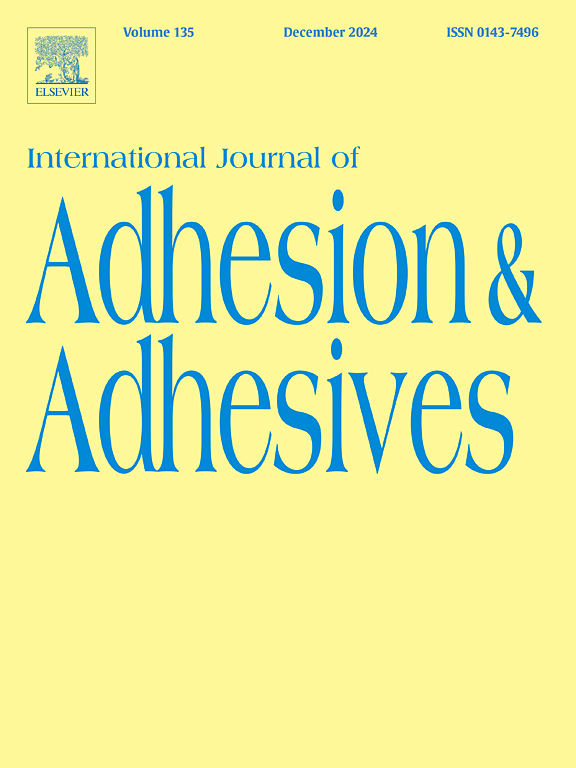30-Month performance of a 10-MDP based universal adhesive system under mechanical and biological perspectives
IF 3.2
3区 材料科学
Q2 ENGINEERING, CHEMICAL
International Journal of Adhesion and Adhesives
Pub Date : 2024-11-02
DOI:10.1016/j.ijadhadh.2024.103869
引用次数: 0
Abstract
Strategies towards the long-term durability of dentin-adhesive interface is the goal of many investigations. As the universal dentin bonding systems (DBS) represents a promissory category, other approaches seem to be refrained. Besides their chemical capacity to bond to dentin, their ability in terms of suppression of dentin metalloproteinases of matrix at the interface is unclear. This study aimed to evaluate the long-term adhesive performance and gelatinolytic activity effect of a 10-MDP-based universal DBS compared with 2 % chlorhexidine digluconate (CHX) as control to connect the understanding of mechanical and biological mechanisms. For this, bond strength to dentin (μTBS) and in situ zymography (Z) at initial, 6-month, and 30-month aging times were run. 102 sound human molars were randomized according to DBS: Adper Single Bond 2 – (SB - MDP-free control); Adper Single Bond Universal in etch-and-rinse (SUER) and self-etching (SUSE) modes. They were subdivided according to dentin pretreatment: W- water or CHX-2% (30s-passive application). The specimens were restored according to the manufacturer's instructions. For μTBS (n = 12), beams (0.64 mm2) were obtained and tested (500N/0.5 mm/min). For Z (n = 5), 0.1 mm-thick slices were incubated with fluorescein-conjugated gelatin (24h/37 °C) and analyzed by confocal laser scanning microscopy. Data were analyzed by three-way ANOVA and Tukey's test (p < 0.05). At 6-month, CHX effectiveness was observed in some circumstances under both tests. However, 30-month assessments evidenced no difference neither among the groups regardless of DBSs nor pretreatment for all comparisons, despite some peculiarities detected under Z. It is concluded that the 10-MDP universal DBS present limited action over the proteolytic action.
基于 10-MDP 的通用粘合剂系统在机械和生物角度下的 30 个月性能表现
牙本质粘接界面的长期耐久性是许多研究的目标。由于通用的牙本质粘接系统(DBS)是一个很有前途的类别,因此其他方法似乎都不适用。除了与牙本质粘接的化学能力外,它们在抑制界面基质的牙本质金属蛋白酶方面的能力还不清楚。本研究旨在评估基于 10-MDP 的通用型 DBS 与作为对照的 2% 洗必泰二氯葡萄糖酸盐(CHX)相比的长期粘接性能和凝胶溶解活性效果,从而将对机械和生物机制的理解联系起来。为此,在初始、6 个月和 30 个月的老化时间内,对牙本质的粘接强度(μTBS)和原位酶图谱(Z)进行了测试。将 102 颗健全的人类臼齿按照 DBS 随机分组:Adper Single Bond 2 -(SB - 不含 MDP 的对照组);Adper Single Bond Universal 的蚀刻-冲洗(SUER)和自蚀刻(SUSE)模式。它们根据牙本质预处理情况进行了细分:W-水或CHX-2%(30s-被动应用)。试样按照制造商的说明进行修复。对于 μTBS (n = 12),获得横梁(0.64 mm2)并进行测试(500N/0.5 mm/min)。对于 Z(n = 5),0.1 毫米厚的切片与荧光素结合的明胶孵育(24 小时/37 °C),并通过共聚焦激光扫描显微镜进行分析。数据采用三方方差分析和 Tukey 检验(p < 0.05)。6 个月时,在两种测试中的某些情况下都观察到了 CHX 的有效性。然而,30 个月的评估结果表明,尽管在 Z 下检测到了一些特殊情况,但在所有比较中,各组(无论 DBS 还是预处理)之间均无差异。
本文章由计算机程序翻译,如有差异,请以英文原文为准。
求助全文
约1分钟内获得全文
求助全文
来源期刊

International Journal of Adhesion and Adhesives
工程技术-材料科学:综合
CiteScore
6.90
自引率
8.80%
发文量
200
审稿时长
8.3 months
期刊介绍:
The International Journal of Adhesion and Adhesives draws together the many aspects of the science and technology of adhesive materials, from fundamental research and development work to industrial applications. Subject areas covered include: interfacial interactions, surface chemistry, methods of testing, accumulation of test data on physical and mechanical properties, environmental effects, new adhesive materials, sealants, design of bonded joints, and manufacturing technology.
 求助内容:
求助内容: 应助结果提醒方式:
应助结果提醒方式:


